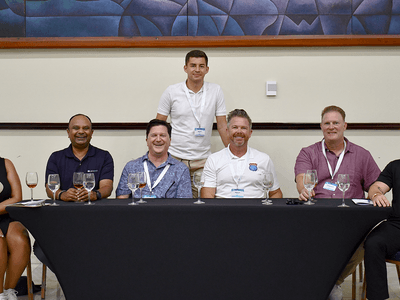AI Won’t Replace Developers. But It Will Reshape How You Build Teams
If you’re a CTO, VP of Engineering, or technical hiring manager, you’ve probably asked yourself: Will AI replace developers? With tools like ChatGPT, GitHub Copilot, and IDE-integrated assistants, it’s tempting to imagine a future where code is written automatically while human engineers step aside.
But the reality, at least for now, is very different. AI is augmenting developers, not replacing them. And the companies seeing the biggest productivity gains are those that combine AI-powered workflows with senior engineering talent who know how to harness it effectively.
At Oceans Code Experts, we’ve had front-row seats to this shift. In conversations with our senior Latin American engineers, one theme is clear: AI accelerates delivery, but only experienced developers can apply business logic, communicate with stakeholders, and ensure long-term scalability.
Let’s break down what this means for your engineering strategy.
How Developers Are Actually Using AI Today
When non-technical leaders hear "AI in software development," they often think only of ChatGPT. But developers are using a variety of AI coding tools every day:
- IDE-integrated assistants like Cursor or Copilot that suggest code completions.
- Debugging helpers that analyze broken code snippets and suggest fixes.
- Automated documentation tools that generate first drafts of technical documentation.
- Code analysis models that highlight areas of improvement or flag bad practices.
One of our senior developers recently compared two scenarios:
- Writing a new feature manually: 3–4 days of work.
- Building the same feature with AI coding assistance: less than one day.
That’s a 70–80% reduction in development time, but only when guided by a skilled engineer who knows how to validate outputs and apply the right context.
The Limits of AI in Development
Despite the hype, AI cannot replace the most critical parts of modern software development, yet:
- Business Logic: AI struggles with domain-specific requirements. It can generate boilerplate, but it doesn’t understand your company’s unique workflows, compliance constraints, or customer needs.
- Stakeholder Communication: Developers aren’t just coders, they’re problem solvers. Translating vague business requests into technical solutions requires empathy, negotiation, and iteration. No AI tool can replace those soft skills.
- Strategic Decision-Making: From deciding what to automate, to choosing the right architecture, senior engineers make trade-offs AI can’t.
The takeaway? AI can automate repetitive coding tasks, but humans must remain in the loop for anything involving judgment, strategy, or collaboration.
3 Ways AI + Developers Work Better Together
For technical leaders under pressure to ship faster, here are the three areas where AI collaboration with senior developers is already paying off:
1. Documentation That Doesn’t Slow Down Your Team
No developer enjoys writing documentation. AI drastically speeds up the process, allowing engineers to generate structured drafts that can be quickly reviewed and refined.
2. Smarter Debugging
Instead of sifting through thousands of lines of code, developers can paste problematic sections into an AI debugging assistant, discuss potential issues, and test alternative fixes faster.
3. Project Scaffolding
When building new applications, AI helps engineers set up boilerplate structures (e.g., frameworks, database connections, email workflows). Engineers can then refine and extend these foundations into production-grade systems.
Common Mistakes Companies Make with AI
We’ve also seen hiring managers and technical leaders fall into dangerous assumptions:
- Overestimating AI: Thinking it’s a “magic genie” that can solve any problem. In reality, misapplied AI often introduces technical debt.
- Underestimating oversight: Copy-pasting AI code without human review leads to bugs, inefficiencies, and security risks.
- Neglecting soft skills: AI won’t handle stakeholder communication or strategic trade-offs. Skilled developers remain essential.
The best practice? Use AI as a force multiplier for experienced engineers, not a replacement for them.
Why Senior Latin American Engineers Are Ideal for the AI Era
At Oceans Code Experts, we’ve learned that the engineers who extract the most value from AI are senior developers who understand when to trust it, and when not to.
Our nearshore software engineers in Latin America bring:
- 10+ years of experience across industries and tech stacks.
- Strong communication skills, ensuring alignment with U.S. stakeholders.
- Cost-effective nearshore collaboration in U.S. time zones.
- Hands-on AI experience, using tools like GitHub Copilot, Cursor, and ChatGPT to accelerate delivery.
This makes them uniquely positioned to help U.S. software companies scale quickly while maintaining high-quality outputs.
Actionable Takeaways for CTOs and Hiring Managers
If you’re leading a development team, here’s how to think about AI in software engineering in practice:
- Automate selectively: Use AI for repetitive or boilerplate tasks, but keep humans in the loop for business logic and architecture.
- Prioritize senior talent: Less experienced developers are more likely to misuse AI. Senior engineers ensure outputs are validated and reliable.
- Invest in communication skills: Ensure your engineers can translate stakeholder needs into effective prompts and code reviews.
- Experiment with multiple models: Don’t rely solely on one tool. Different AI models excel at different tasks.
Final Thoughts: The Future Is Human + AI
The future of software engineering isn’t about choosing between AI developers vs. human developers, it’s about combining them. AI speeds up coding, testing, and documentation, but experienced engineers are the glue that holds projects together.
The winning companies will be those that staff teams with senior engineers who know how to wield AI effectively.












